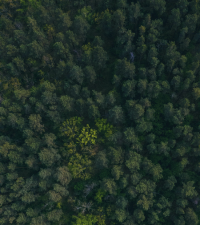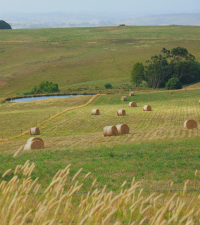
The following is a guest contribution from Arian Aghajanzadeh, the founder of Klimate Consulting.
According to the Intergovernmental Panel on Climate Change (IPCC), our food system accounts for 21–37% of total global greenhouse gas (GHG) emissions. This makes our food system the single largest source of emissions on earth. However, our global food system can become the single largest sink of carbon by changing how we manage our lands and farming regeneratively. Through regenerative farming, we not only sequester carbon but promote soil health which can have several other benefits. So why is such a big opportunity to make our food supply system sustainable, remove carbon from the air, increase our soil health, and reverse climate change often overlooked?
The answer is simple, we do not know enough about our food’s environmental footprint and we tend to underestimate its footprint. Food sustainability is also not talked about as much as other environmental topics such as solar, batteries, and electric vehicles. For many years, we have been disconnected from our food supply system due to its complex nature. Our food system touches every industry on earth and understanding its environmental footprint is a massive undertaking, historically done by large research and academic institutions.

In recent years, there has been an awakening among the average consumer and they are now demanding to know more about the food they consume. As more consumers demand transparency in the supply chain of their food, producers are looking into ways to address that demand by providing carbon or eco-labels on their products. However, we are only starting to scratch the surface when it comes to eco-labeling our food products.
Eco-Labels 2.0
Eco-labels are not new. In fact, the first carbon label was introduced by the Carbon Trust in 2006 in the UK and was called the “Carbon Reduction Label”. In 2008, the UK and Japan piloted carbon labeling projects for select products. However, three years later in 2012, UK’s supermarket giant Tesco stopped using carbon reduction labels on its products, claiming it is too costly and burdensome. Today, almost a decade later, a new era of carbon labeling is emerging. This time, climate change is an even more serious threat and new research is backing up the effectiveness of eco-labels for reducing carbon emissions.
Over the past few years, more brands have started to adopt carbon labeling strategies and many organizations have entered that space to help brands do their supply chain carbon accounting and summarize the results in an easy-to-understand carbon label. However, the main challenge is still the same as what stopped carbon labels back in 2012. Calculating the carbon footprint of any given product is painstakingly complicated. The lack of guidelines for carbon accounting is another hurdle forcing many organizations to come up with their own methodologies for doing that work (e.g. Just Salad, allbirds, Oatly, PlanetFWD), which leaves a lot of room for assumptions.
Current Solutions and Limitations
All existing eco-labels rely on some sort of Life Cycle Assessment (LCA), whether they are conducted by academics, consultants, or technology companies. All LCA studies have limitations that sometimes lead to skepticism about their results. LCAs attempt to assess the real world in a simplified model, and thus come with assumptions and scenarios. They can vary widely depending on their set of assumptions as one study may leave out impacts or processes that another study has included.
As outlined in the ISO 14040 international standard, an LCA consists of four main phases: (i) defining the goals and scopes; (ii) inventory analysis; (iii) calculation and assessment of environmental impacts; and (iv) interpretation of the results. Also, all LCA studies need to take into account relevant boundaries (e.g. farm to fork), determine functional units (e.g. product, service, or system), type and quality of data, environmental performance metrics (e.g. GHG emissions, water, land use, etc.), and sensitivity analysis to check the stability of the results.
This is especially challenging when it comes to eco-labeling our food products. Our food system is extremely complex and its supply chain touches almost every industry in existence (agriculture, water, energy, transportation, manufacturing, and retail). Any eco-label that tries to capture everything that touches our food will quickly become a data-intensive study, beyond the scopes of even the largest food companies. That is why many brands are left with a few options, either to let go of eco-labels, hire outside consultants and pay for costly LCA datasets, or try to come up with their own overly simplified (often inaccurate) models.
Even with the best modeling approach, all LCAs are frozen in time and space, meaning that they need to be repeated over time and for different geographical regions. In a 2019 study, researchers at the University of California, Berkeley looked into the effects of transportation, localness, and seasonality on US fresh orange markets (Figure 2). It turns out that major US cities receive oranges depending on the time of year either by truck from Florida, Mexico, Texas, via rail from California, and by containership from Australia, Chile, and South Africa. Each has a very different LCA resulting in a variable carbon footprint depending on the time of year.

The example above is just one of many shortcomings of existing LCA models. Now that we have highlighted the challenges and shortcomings of existing approaches, we also need to discuss what the alternative to LCAs would look like.
Rethinking the LCA
For many years we have relied on LCAs because data and traceability have been nearly non-existent in our agricultural and food supply system. It is also important to mention that LCAs are currently our only solutions for determining scope 3 emissions and are the only accepted methodology by several protocols such as Global Reporting Initiative (GRI) and the Greenhouse Gas Protocol.
But what if with the proliferation of sensors and remote sensing technologies, data could be collected in real-time and with high spatial resolution at the farm, throughout the food supply system, and all the way to the consumer (cradle to fork)? If that type of traceability and data collection becomes a new normal, LCAs will be a thing of the past.

Unfortunately, we are far away from having complete traceability in our food system, but in an ideal world, every entity that touches our food, from farm input providers, (large chemical manufacturers), to the tractors running through our fields and harvesters, to the trucks transporting our food, to the food processor and cold storage facilities, and the retailer, could keep a record of how our food is produced and handled. In the end, all that data will be aggregated and presented to the consumer, all in real-time and with actual information, not a modeled output.
Historically, it was easy to get away with low-quality carbon accounting and labels, but as more consumers become carbon literate, they will be demanding more information and higher levels of transparency into the environmental footprint of products that they purchase. So it is time to re-think how we calculate footprint data, and instead of static LCAs find more creative ways to leverage technology for collecting real-time data with high spatial resolution. We cannot reverse climate change without fundamentally changing our food system and without widespread use of eco-labels we cannot make that fundamental change.
Arian Aghajanzadeh has over 10 years of experience working with agricultural, water, and energy stakeholders in California and most of Western United States. Arian believes that we cannot reverse climate change without addressing hard to decarbonize sectors such as food and agriculture. Arian is the founder of Klimate Consulting, a sustainability firm that provides technical assistance, tools, and resources for food, energy, and water decarbonization.


.png)
